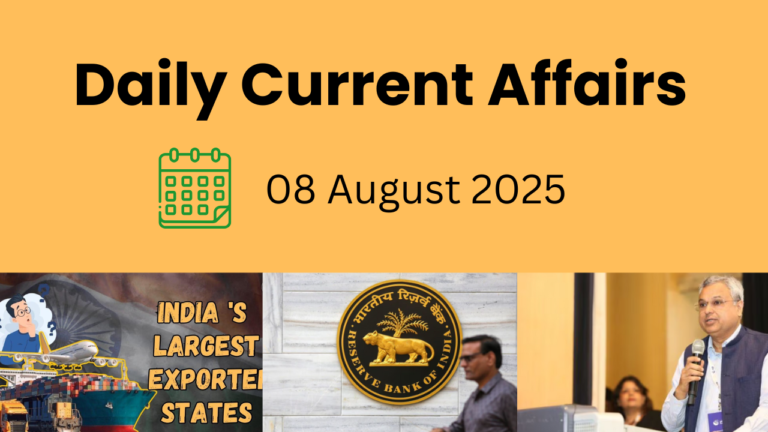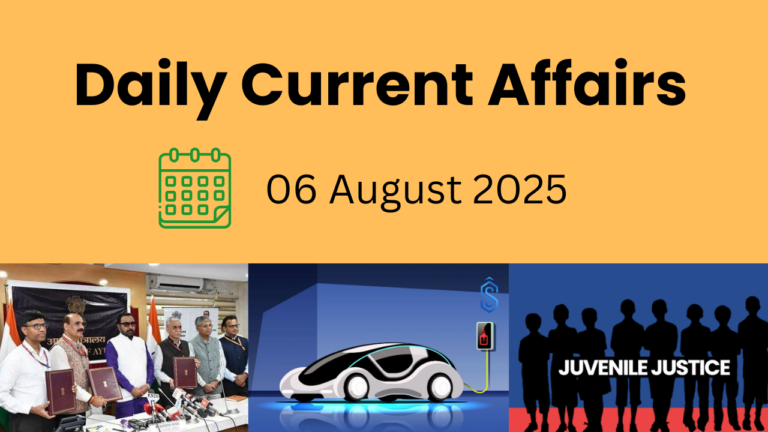1. New Income Tax Bill 2025
Context: Finance Minister Nirmala Sitharaman has presented the New Income Tax Bill, 2025, in the Lok Sabha, aiming to simplify tax laws and make compliance easier.
Introduction: The government has proposed the Income Tax Bill 2025 to create a simpler, more transparent, and streamlined tax regime. Announced during the Union Budget on February 1, 2025, the bill eliminates outdated provisions, introduces clearer terminology, and replaces the term ‘assessment year’ with ‘tax year’.
Although the fundamental tax structure remains unchanged, experts view this bill as a significant step towards modernizing India’s taxation system. If approved, it will come into effect from April 1, 2026.
Key Features of the New Income Tax Bill:
Introduction of the ‘Tax Year’ Concept:
- The bill defines a ‘tax year’ as a 12-month period starting from April 1.
- Unlike the current system, where income earned in one financial year is assessed in the following year, the new system will assess income within the same tax year.
- For businesses established mid-year, the tax year will begin from the date of setup and end on March 31.
Simplified Language for Better Understanding:
- The bill removes complex legal jargon, reducing the need for excessive cross-referencing.
- The total length of the tax bill has been reduced from 823 pages to 622 pages, despite keeping the number of chapters the same at 23.
- The number of clauses has increased from 298 to 536, making the provisions more structured and easier to comprehend.
Expanded Definition of ‘Income’:
- Virtual Digital Assets (VDAs), including cryptocurrencies and NFTs, are now included as taxable assets.
- This aligns VDAs with existing capital assets such as land, buildings, shares, bullion, and artwork.
Elimination of Redundant Provisions:
- The bill removes outdated exemptions, such as Section 54E, which provided capital gains exemptions for transactions before April 1992.
- Unnecessary amendments and outdated references have been scrapped.
Clearer Tax Provisions:
- Several tax-related provisions, including TDS (Tax Deducted at Source), presumptive taxation rates, and assessment time limits, have been consolidated into easy-to-read tables.
- Deductions for salaries (such as standard deduction, gratuity, and leave encashment) are now grouped together under one section for better clarity.
Reforming the Dispute Resolution Process:
- The Dispute Resolution Panel (DRP) will now provide:
- Points of determination
- Detailed reasons for its decisions
- Clear justifications for rulings
Impact on Taxpayers and Businesses:
Easier Compliance for Taxpayers:
- The bill removes excessive cross-referencing, making tax laws easier to navigate.
- Legal terms have been simplified, replacing complex words like “notwithstanding” with simpler alternatives like “irrespective of anything.”
Smoother Tax Filing and Compliance:
- Provisions related to revenue recognition, inventory valuation, and income exclusions have been consolidated into schedules instead of being scattered across multiple sections.
- Wealth tax-related provisions have been integrated, reducing the need for external references.
Recognition of the Digital Economy:
- The bill includes specific provisions for digital assets and service-based revenues, reflecting the modern structure of the Indian economy.
- Income generated from digital assets and online services is now categorized clearly under capital assets.
Challenges & Future Implications:
No Major Structural Reforms:
- The bill focuses on simplification rather than major policy changes.
- There are no alterations in tax rates, penalties, or compliance mechanisms.
Transition to the ‘Tax Year’ Concept:
- Taxpayers and businesses may require time to adapt to the new system.
- Financial professionals and accountants will need to update their taxation models and planning strategies.
Pending Approval from Parliament:
- The bill has been introduced in Lok Sabha but still needs to be reviewed by a parliamentary mmittee before final approval.
Conclusion:
The Income Tax Bill 2025 is a significant step toward simplifying and modernizing India’s tax system. The introduction of the ‘tax year’ concept, removal of redundant provisions, and streamlined tax structures aim to make compliance easier and more transparent.
However, while the bill enhances clarity and efficiency, it does not introduce major tax rate changes or structural reforms. The government is prioritizing continuity and simplification, potentially paving the way for more substantial tax reforms in the future.
2. TRAI’s New Rules to Tackle Spam Calls & Messages
Context: India’s telecom regulator, TRAI, has introduced new regulations under the Telecom Commercial Communications Customer Preference Regulations (TCCCPR), 2018, aimed at reducing spam calls and messages.
Leading telecom providers such as Airtel, Jio, and Vi must now monitor call and SMS patterns in real time to detect and report spammers. Any failure to comply will result in hefty penalties ranging from 2 lakh for the first offense to 10 lakh for repeated violations.
These updated regulations aim to protect consumers from intrusive spam communication and ensure a more secure and transparent telecom network.
How TRAI is Cracking Down on Spam Calls & Messages:
1. Faster Action Against Spam:
- Consumers can now report spam calls and messages more easily.
- Telecom operators must take action within 5 days, a major improvement from the earlier 30-day timeframe.
2. Clear Identification of Spam Calls:
- Telemarketers can no longer use normal 10-digit numbers for promotional calls.
- Instead, calls will be categorized as:
- 140 series – Reserved for promotional calls.
- 1600 series – Dedicated to transactional and service-related calls (already in effect).
3. Opt-Out Option for Promotional Messages:
- Users can now easily opt out of promotional messages through telecom providers.
- However, they will have the flexibility to opt back in whenever they choose.
4. Stricter Monitoring of Spam Activity:
- Telecom operators will analyze call and SMS patterns in real time based on:
- High call volumes
- Short call durations
- Unusual incoming-to-outgoing call ratios
- This monitoring will help identify and block spammers more effectively.
5. Stronger Verification & Harsher Penalties:
- Telemarketers must now undergo physical verification, biometric authentication, and link their mobile number to their identity.
- Repeat violators will have all their telecom resources permanently blocked.
- Telecom companies are required to maintain detailed records of spam complaints and sender details to ensure quick and effective action.
Spam Calls: A Growing Problem in India
Millions of Indians face relentless spam calls every day, especially from banking, insurance, and financial service providers. Despite multiple crackdowns, the problem has continued to worsen over time.
A LocalCircles survey (Feb 2023) of 12,000 respondents found that:
- 60% receive three or more spam calls daily.
- 30% get one to two spam calls every day.
- 36% receive three to five spam calls daily.
- 21% report receiving six to ten unwanted calls each day.
- 3% are bombarded with over ten spam calls daily.
With telecom operators sometimes playing a role in the rising spam call surge, TRAI’s new stringent measures aim to bring relief to millions of frustrated consumers.
3. Trump-Putin Talks: US Pushes for Ukraine War Settlement
Context: In a major diplomatic move, President Donald Trump held a “lengthy and highly productive” conversation with Russian President Vladimir Putin—their first confirmed dialogue since Trump’s return to office.
The discussion marked the beginning of a US-led initiative to negotiate an end to the Ukraine war, signaling a potential turning point in global diplomacy.
Trump Takes on Mediator Role in Ukraine Conflict:
Trump’s Renewed Focus on Ending the War:
From the start of his second term, Trump has made ending the Ukraine war a priority. His administration is working towards facilitating peace talks between Russia and Ukraine, aiming to bring stability to the region.
Russia’s Response & Diplomatic Signals:
- The Kremlin confirmed the 90-minute conversation between the two leaders.
- Putin welcomed Trump’s peace initiative, acknowledging the need for both nations to work together on global stability.
Trump’s Evolving Stance on Russia:
- Trump’s approach to Russia has shifted significantly from his first term, when he was accused of being too accommodating toward Putin.
- While he previously praised Putin’s strategic tactics, he has now adopted a more critical position, questioning Russia’s conduct in the war.
Challenges Facing the Peace Process:
Despite Trump’s diplomatic push, there are several obstacles to achieving peace:
- Ukrainian President Zelenskyy remains unwilling to compromise Ukraine’s sovereignty, especially given strong military and financial backing from the West.
- Western nations remain skeptical of Russia’s intentions, fearing that Moscow may use negotiations as a delay tactic while solidifying its hold over eastern Ukraine.
Europe Pushes for a Role in Peace Talks:
European Leaders Demand Inclusion:
European leaders have made it clear that Ukraine and Europe must be involved in any diplomatic resolution.
Trump’s Shift on NATO & Ukraine’s Borders:
- Trump has hinted at a major policy shift, suggesting that Ukraine should abandon its NATO ambitions.
- He has also questioned whether Ukraine’s pre-2014 borders are realistic, indicating a possible compromise with Russia.
US Prioritizing Other Global Concerns:
Experts suggest that Trump’s administration is shifting focus away from European security, instead emphasizing:
- Border control policies
- Strengthening US-China deterrence
The Importance of the Trump-Putin Call:
A Shift in Global Power Dynamics:
Trump’s direct negotiations with Putin signal a major departure from past US foreign policy.
- He invoked World War II comparisons, likening his diplomacy with Putin to the historic Yalta Summit.
- This move effectively ends Russia’s diplomatic isolation, which had lasted over a decade.
A Ceasefire in Sight?
- Trump announced immediate talks to negotiate a ceasefire in Ukraine.
- A meeting with Putin in Saudi Arabia is already in the works, hinting at a potential diplomatic breakthrough.
Europe’s Absence from Negotiations:
- Much like in 1945, Europe has been sidelined in US-Russia negotiations.
- Trump’s administration rejects Ukraine’s NATO membership bid, acknowledging that reclaiming lost territories is increasingly unrealistic.
Russia’s Weakened Position Could Encourage Negotiations:
- Past US-Russia talks, including Biden’s 2021 Geneva summit with Putin, collapsed due to Moscow’s rigid demands.
- However, after three years of war, Russia’s position has weakened, making it more likely to consider serious negotiations.
Could Trump Visit Moscow?
If successful, Trump may visit Moscow for Russia’s Victory Day in May, a symbolic step towards a US-Russia deal.
For Putin, this would mean recognition of Russia’s great power status and a shift in Europe’s security structure in Moscow’s favor.
What This Means for Asia & India:
Asia’s Geopolitical Landscape Could Change:
If Trump succeeds in brokering a Ukraine peace deal, his next focus may shift towards China.
Key questions arise:
- Will Trump shift his foreign policy towards countering China?
- Could he extend his peace negotiations to Taiwan?
- How will a potential US-Russia reconciliation impact Moscow-Beijing relations?
Implications for India:
For India, this is a critical moment in global diplomacy.
- Unlike in the 20th century, India now holds significant geopolitical influence.
- PM Modi’s upcoming meeting with Trump will be a chance to understand his larger global strategy.
Economic & Trade Considerations:
Beyond geopolitics, India and the US may collaborate on economic restructuring:
- Countering China’s trade dominance will be a major topic.
- With both nations facing large trade deficits with China, Modi might align with Trump’s push for a new economic order led by democratic nations.
As the global power balance shifts, all eyes are now on how Trump’s Ukraine peace efforts unfold and what they mean for the future of international diplomacy
4. President’s Rule Imposed in Manipur, 11th Time in State’s History
Context: The President of India has issued a proclamation imposing President’s Rule in Manipur, placing the state assembly under suspended animation.
This marks the 11th instance of President’s Rule in the state, with the last imposition occurring in 2001-02.
What is President’s Rule?
Constitutional Provision: Article 356:
Under Article 356 of the Indian Constitution, the President can impose central rule in a state if:
- The Governor’s report indicates that the state government is unable to function as per constitutional provisions.
- The President is satisfied that the state’s governance cannot be carried out in accordance with the Constitution.
Duration & Parliamentary Approval:
- As per Article 356(3), President’s Rule remains in effect for two months unless approved by both Houses of Parliament through a simple majority.
- If approved, it can be extended up to six months.
- The maximum duration is three years, but Parliament must approve an extension every six months.
How Can It Be Revoked?
- President’s Rule can be revoked by the President through a subsequent proclamation, restoring normal governance in the state.
What Happens When President’s Rule is Imposed?
- The President takes over the functions of the State Government and assumes the powers of the Governor.
- The state legislature’s powers are transferred to Parliament.
- The functioning of the High Court remains unaffected.
Key Judicial Ruling: S.R. Bommai vs Union of India (1994):
- The Supreme Court ruled that President’s Rule under Article 356 is subject to judicial review.
- The President cannot dissolve a state legislative assembly immediately—this can only happen after parliamentary approval of the proclamation.
- Until Parliament grants approval, the state assembly remains suspended, not dissolved.
Significance of the Latest Imposition in Manipur:
With political instability in Manipur, the central government has once again invoked Article 356, taking direct control of the state’s governance. The move raises questions about governance, constitutional mechanisms, and the future political landscape of Manipur.
All eyes are now on the Parliament’s decision on whether to extend or revoke President’s Rule in the state.
5. Union Government Releases Report on Panchayat Devolution Status
Context: The Union Government has released a report titled ‘Status of Devolution to Panchayats in States – An Indicative Evidence-Based Ranking’, offering a detailed assessment of how effectively Panchayats function under the 73rd Constitutional Amendment.
This report provides key insights into the progress of devolution, highlighting areas of improvement and major challenges.
Key Findings of the Report:
Panchayat Devolution Index:
The report ranks States and Union Territories based on six key dimensions of devolution:
- Framework
- Functions
- Finances
- Functionaries
- Capacity Enhancement
- Accountability
- Overall devolution has improved from 39.9% in 2013-14 to 43.9% in 2021-22.
- Top 3 States in Devolution:
- Karnataka
- Kerala
- Tamil Nadu
Capacity Building Improvements:
- Capacity enhancement for Panchayats has increased from 44% to 54.6%, driven by initiatives like the Rashtriya Gram Swaraj Abhiyan (RGSA).
Challenges Hindering Effective Devolution:
1. Election Management Issues:
- State Election Commissions (SECs) are sometimes forced to consult state governments on election dates, leading to delays and potential political interference.
2. Weak Implementation of District Planning Committees:
- District Planning Committees (DPCs) are constitutionally mandated under Article 243ZD, yet detailed grassroots-level planning is rarely undertaken in most states.
3. Panchayats Overlooked in Governance:
- Multiple parallel bodies operate in areas meant for Panchayats under the Eleventh Schedule, weakening their constitutional authority.
Key Recommendations for Strengthening Panchayats:
1. Empowering State Election Commissions (SECs):
- Grant full autonomy to SECs, ensuring they can independently handle election schedules, delimitation, and seat reservations, without state government interference.
2. Strengthening Panchayat Governance:
- Establish structured district planning frameworks, ensuring Panchayats work in alignment with state and national policies.
3. Direct Fund Allocation to Panchayats:
- Ensure all funds for subjects listed in the Eleventh Schedule are transferred directly to Panchayats, rather than being diverted through parallel bodies.
The Way Forward:
The findings of the rep:ort emphasize the progress made in empowering Panchayats but also highlight critical gaps in governance and autonomy.
With proper implementation of the recommendations, Panchayats can be strengthened to play a central role in local governance, ensuring effective grassroots democracy and development across India.
6. India Ranks Sixth in Global Climate Risk Index
Context: A recent Climate Risk Index (CRI) report has revealed that India ranks sixth among the top 10 countries most affected by extreme weather events over the last three decades (1993-2023).
This ranking highlights the increasing vulnerability of India to climate-related disasters, including floods, heatwaves, and cyclones.
What is the Climate Risk Index?
- Introduced in 2006, the Climate Risk Index (CRI) is one of the longest-running annual reports assessing the impact of climate-related extreme weather events on different nations.
- The index evaluates realized risks, ranking countries based on the economic and human toll, including:
- Fatalities
- Injuries and affected populations
- Homelessness and financial damage
- The rankings are based on data from the International Disaster Database (EM-DAT) and economic statistics from the International Monetary Fund (IMF).
- The CRI is published by Germanwatch, a Bonn- and Berlin-based independent development, environment, and human rights organization.
Key Findings of the Report:
- India remains among the 10 most affected nations due to extreme weather between 1993 and 2023.
- The country accounted for 10% of global fatalities caused by climate disasters and 4.3% of worldwide financial losses (in dollar terms).
- India ranked sixth in the Climate Risk Index 2025, reinforcing its position as one of the most climate-vulnerable nations.
- The top five most affected countries ahead of India in the rankings include:
- Dominica
- China
- Honduras
- Myanmar
- Italy
Climate Disasters and Their Impact on India:
- India has suffered from more than 400 extreme weather events over the last three decades.
- These events caused financial losses of $180 billion and resulted in at least 80,000 deaths.
- Major climate-related disasters include:
- Severe floods in 1993, 1998, and 2013.
- Devastating heatwaves in 2002, 2003, and 2015.
- Frequent and intense cyclones along the coasts.
The Growing Climate Crisis:
The latest Climate Risk Index report reinforces the urgent need for climate resilience strategies, disaster preparedness, and sustainable policies in India.
As extreme weather events become more frequent, India must focus on strengthening climate adaptation measures, improving early warning systems, and promoting sustainable development to mitigate the devastating impacts of climate change.




